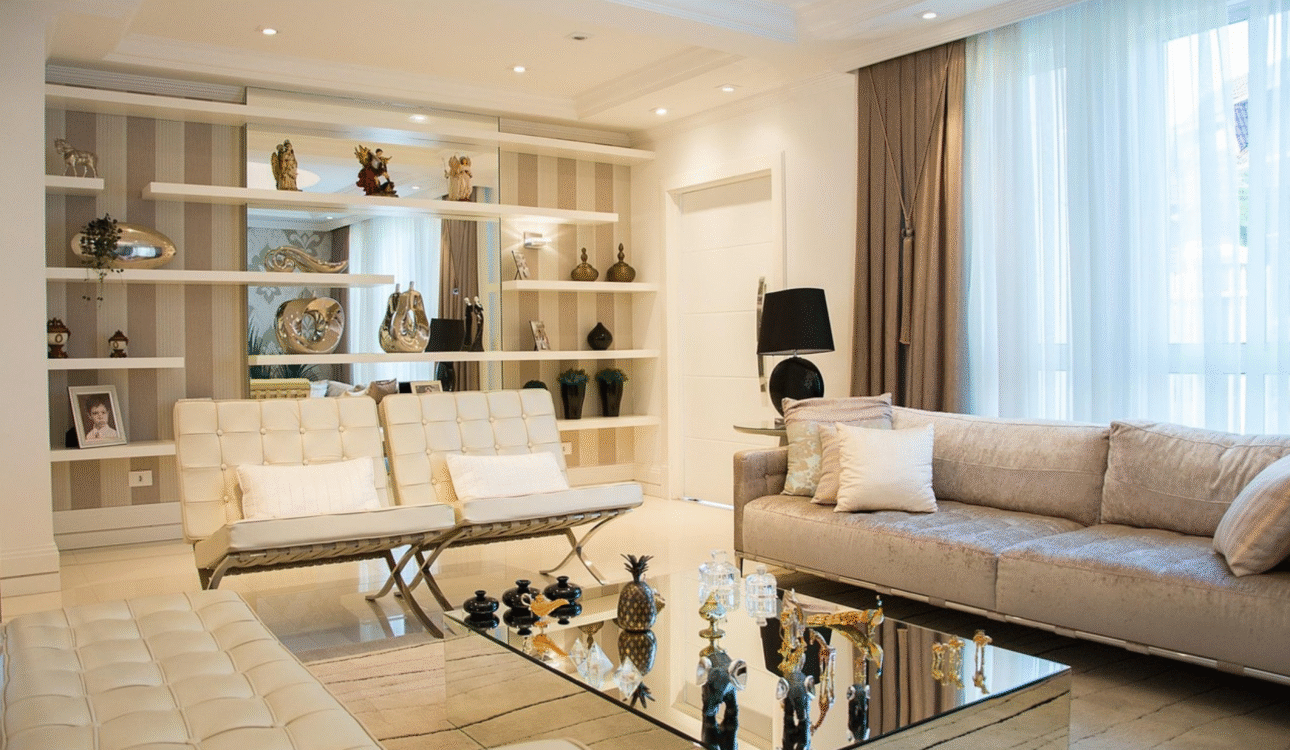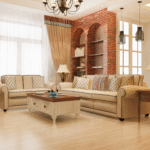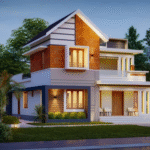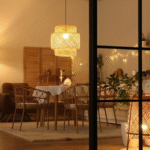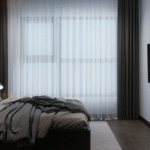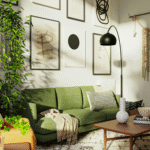It is a fact that every homeowner dreams of spaces that feel balanced, beautiful, and functional. When designing your home, it is not just about selecting the right colour tones or purchasing some statement furniture to adorn the interiors. It goes beyond that. What matters most is creating spaces that look as well as feel right and practical. Besides style and substance, every perfect home interior design is made based on key interior design principles. With the proper understanding of these central design concepts, you will be able to create a perfect combination of visually appealing and functional rooms. However, you must approach them quite seriously and with an exceptional perspective. Now, if you are wondering what these fundamental interior design principles are, well, you are at the right spot. This blog will cover the 7 interior design basic concepts, such as balance, harmony, rhythm, emphasis, proportion, contrast and details, with practical interior design tips for homeowners .
1.Balance-Creating Visual Stability
In interior design, balance denotes to the symmetrical and geometrical use of spaces, which indeed proves to be one of the most decisive factors. It is the balance that gives a feel of equilibrium for your interiors and happens to be the foundation of every beautiful space.
What is Balance in Design?
When you think about balance, it is creating spaces with the even distribution of beautiful home décor and furniture so that you get an equal visual weight while looking at them. Now, if you want to achieve balance, it is important to place them at the precise places within the available space of a room. To do this, you must carefully analyse the line, colour, shape, as well as texture of different objects, so that you will get a clear idea of how to get going in the right way. Balance in design are of three types, and they are:
Symmetrical or Formal
This commonly used type of balance is inclined to create mirror images in your spaces that result in bilaterally symmetric rooms. Symmetrical balance is a conventional approach when it comes to interior design and is apt for square rooms. Symmetrical or formal balance can be achieved by ensuring that every furniture and home décor is placed around its axial points. This is exactly what drives the symmetrical balance feel for your rooms. For instance, two chairs symmetrically drawn against each other with a table in the centre will be a great idea for achieving a balanced design. Symmetrical balance looks very appealing, especially for living rooms, and this is why interior designers in kochi kerala mostly go for this design style.
Asymmetrical or Informal
Now, when it comes to asymmetrical balance, without going for exact duplication, you can balance the visual weights of forms, textures, colours and lines. Unlike symmetrical balance, this type of balance does not give importance to geometrical placements. This makes it more exciting. For instance, your sofa can be visually balanced with two chairs placed on the other side of it.
Radial Balance
This type of balance tends to be more complex. It is because radial balance revolves around the central elements placed in spaces. This happens to be the focal point. Every other sub-element will get harmonised due to this main focal point in your room. This type of balance helps you to create aesthetically coordinated interiors. A practical example is a round dining table and chairs placed around it.
How to Achieve It at Home
You can match furniture on either side of your sofa for a symmetrical design or balance a large artwork with smaller pieces of décor to adorn the asymmetrical design. The main idea of maintaining balance, irrespective of the type, is that it provides a sense of order and calmness to home interior design in Kochi apartments or villas.
2.Harmony and Unity-Making the Space Feel Connected
Harmony and unity happen to be one of the fundamental interior design basics that can never be overlooked. It is harmony that helps you bring all design elements into sync so that you can create a unified and seamless look for your interiors. For creating harmony, you can:
- Go for a consistent colour palette across all your rooms
- Repeat textures such as warm wood tones for your furniture, floorings and doors
- Be it modern, urban contemporary or rustic-chic, stick to a unified interior style
The Power of Consistency
The principle of harmony itself is driven by two main factors, namely similarity and coordination. Very crucial to maintain consistency. Interior design elements such as colours, textures, shapes and colour repetitions can be used to achieve the power of consistency.
Creating Unity Through Colour and Theme
One of the best ways to create unity is to repeat materials like warm wood for your floors, doors, and furniture throughout your home interiors. Likewise, you can go for the same colour tones. Application of harmony ensures that your interiors look and feel intentional and not chaotic.
2.Rhythm-The Flow of Design
The combination of interior design basics results in the perfect arrangement of rhythm in your home interiors. Needless to say, rhythm proves to be a significant factor when you design a layout and adds movement and energy to your rooms. This is done by incorporating design elements like lines, shapes and colours repetitively to bestow the right design flow.
Understanding Rhythm in Interiors
Rhythm is considered the visual tempo created by the usage of all the important design elements in a repeating format for your interiors. By doing so, your interiors will adorn that rhythmic appeal.
Practical Ways to Add Rhythm
You can create rhythm by repeating your cushion patterns, wall colours and style of lighting fixtures in such a way that your eyes smoothly glide around the room. The creative usage of interior design elements in a repetitive style in modern Kochi home designs helps you to create an appealing flow, especially where open spaces are common.
4.Emphasis-Creating a Focal Point
Both rigidity and monotony are essential factors when it comes to the creation of beautiful, strong-headed interiors. You can use them to your greatest advantage by incorporating different decor elements as strong focal points inside your interiors, around all other sub-elements. The basic principle is to use statement elements and place them appropriately, and bring in other sub-elements to create a visual monotone to your interiors.
What Is a Focal Point?
A focal point is simply something that attracts your gaze, besides anything else present around. In this context, you can use statement artworks, grand-looking chandeliers and other captivating home décor to create focal points in your room interiors.
How to Use It Effectively?
For instance, you can bring in a bold-coloured sofa to a neutral-looking room or adorn a colourful feature wall behind your TV. It would be visually more appealing and much practical to have a focal point in all your rooms. This will help you to create attractive spaces and, at the same time, avoid confusion.
5.Proportion and Scale-Keeping Things in the Right Size
The basic idea of proportion and scale in modern home interior design has evolved from the core concepts of balance and harmony. Scale here refers to the size of both the main elements and sub-elements arranged in your home interiors. It is all about sizing the elements in a correct manner within a room. Always remember that choosing the right-sized furniture and décor is crucial because it ensures you are striking the right chords between balance and comfort. The point is that nothing should feel off, but must be in the perfect shape and size. For instance, a large-sized floor rug in a compact room can make the space look quite cramped.
Understanding Proportion vs. Scale
In home interior design, proportion means ensuring that every element inside your rooms seamlessly fits together. On the other hand, scale mainly focuses on how good these elements fit with the rooms themselves. Therefore, both proportion and scale matter when you want to keep your interiors attractive and practical.
How to Apply It in Home Design
Every interior designer in kochi strives to make sure every room is designed with emphasis given to proportion and scale. They will tell you to avoid oversized furniture, especially in small Kochi apartments. They will also suggest that you maintain proper space between all the décor items used in your interiors. One of the finest ways to ensure the apt proportion and scale for your interiors is to follow the golden ratio. The golden ratio refers to the 60-30-10 ratio. As per the golden ratio, all the major elements occupy 60% of a room. The sub-elements take up the rest of the 30% and the accents occupy the remaining 10%. So, understanding the importance of the golden ratio would be very helpful.
Another way to ensure the finest proportion and scale for your interiors is to embrace the 70/30 rule for home interior design. The materials used, the main colour scheme and design style will account for 70%. At the same time, the rest of the 30% will have contrasting character accents to create ideal room interiors.
6. Contrast-Adding Depth and Visual Interest
There are numerous ways by which you can make your interiors appear more dynamic, and one way is the use of colour. The pairing of light and dark colours will help you create a striking contrast. The same idea can be applied with mild and bold colours. Besides that, you can also experiment with the mixture of textures, scales, and patterns to create contrast-adding depth and visual interest.
The Role of Contrast
Home interior design Kochi is now becoming more popular due to all the unique and trendy concepts. Nowadays, designers give more emphasis on contrast as it is very effective in creating attractive interiors.
Ways to Use Contrast at Home
You can try pairing dark cabinets with light countertops. Or else, you can also mix metal accents with soft fabrics. However, be mindful not to overdo it. The effects of contrast must be used to energise and not to overwhelm.
7. Details-The Finishing Touches That Matter
The last and one of the most important aspects of interior design is the attention given to the slightest details. It is the finishing touches to these details that significantly complement every other design element of your home interiors.
Why Details Matter?
Details like your handles, trims, lighting fixtures and cushion textures very well add up to the overall aesthetics of your interiors and help you create a perfect overall ambience.
Practical Detailing Tips
You can use consistent curtain styles, or experiment with different types of materials for your handles, like metals, wood, etc. Another way is to bring in small green plants to beautify your interiors. Always remember that good detailing is what distinguishes a professionally designed home space from a mediocre one.
Conclusion-Designing with Confidence and Clarity
For creating harmonious and functional spaces, you must master the 7 basics of interior design that we discussed here. You can experiment with these interior design principles by keeping your personal preferences in mind. If you are planning to refresh your home interior design Kochi, consulting a professional designer who can help you apply these principles perfectly to your unique space. Contact Atlas Interiors now and transform your abode into a beautiful paradise.
FAQs
1.What are the 7 basic interior design principles?
They are balance, harmony, rhythm, emphasis, proportion & scale, contrast and details.
2. Why are these principles crucial for home design?
They help you to ensure that every design concept works cohesively and to your utmost advantage.
3. Can I experiment with different styles and still follow these principles?
Yes, very much. The key is to make use of contrasts and unity in a wise fashion.
4. Are these principles tailored only for large homes?
No, these principles apply to any type of home space.
5. How do professional designers make use of these principles?
They use it as a base to create their core design concepts and deliver the best results.

